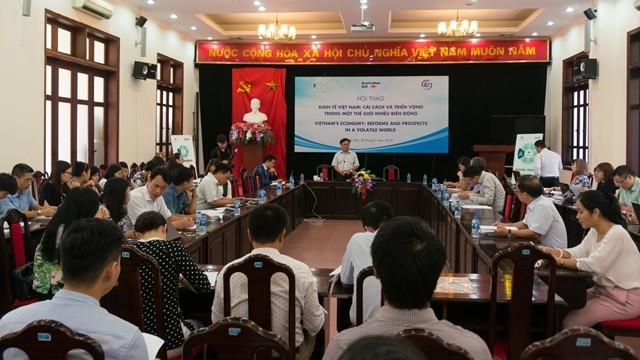* Information is key to monitoring Vietnam’s SOE performance: think tank
The figures were released at a seminar themed "Vietnam's Economy: Reforms and Prospects in a Volatile World," held in Hanoi, on July 20, by the CIEM, with support from the Australian-funded programme called Australia Supports Economic Reform in Vietnam (Aus4Reform).
The event aimed to assess the macroeconomic developments in the second quarter and the first six months of 2018, updating the macroeconomic outlook for the whole year of 2018, and recommend the major orientations for macroeconomic economic management in the second half this year.
According to CIEM's report, Vietnam's economy is still in a period of expansion in the cycle of growth. Accordingly, export growth for the whole year is forecast at 12.11%, while the figure for trade surplus is predicted at US$1.2 billion, in addition to 3.93% in average inflation for 2018.
The report showed that the basis for these forecasts lies in the improvements in the business environment and economic restructuring, along with the government's macroeconomic stability priorities deployed in the previous quarters. The economic growth being maintained, coupled with changes in the business environment, has helped to boost the confidence of domestic enterprises and foreign investment.
Economic growth in the first six months of the year witnessed a range of positive signals. Especially, the agriculture, forestry and fishery sector recovered remarkably, rising by 3.99% in the second quarter of 2018 and 3.93% in the first six months. Growth of the industry-construction sector was at 8.46%, with a bright spot in the high growth in processing and manufacturing industries and a reduction in dependence on the mining sector. The services sector growth was 7.3% - the highest level in the same period since 2010.
During the six-month period, export turnover was estimated at US$113.93 billion, up 16.3% over the same period last year. Import turnover was at US$110.8 billion, up 9.6%. The trade surplus surged to US$671 million in the second quarter and nearly US$3.4 billion in the first six months.
The average CPI in the first six months increased by 3.29% over the same period last year. Inflation remained stable at a low level, increasing on average by 1.35% in the first six months of the year, the lowest level in many years.
Total social investment increased by 11% in the second quarter and 10.1% in the first six months. The ratio of investment to GDP in the Q2 was 33.6%. Rapid investment growth was recorded in the non-state sector as a result from efforts to improve the business environment and maintain stable interest rates and inflation.
Giving his predictions on the macroeconomic developments in the last six months of the year, Nguyen Anh Duong, Head of CIEM’s Macroeconomic Policy Department, said that with a high level of liberal trade, Vietnam's import and export activities could be affected by the complexity of the escalation in the US-China trade tensions. In addition, geopolitical disputes, especially in Asia Pacific, as well as the likely fluctuations in interest rate hikes in the US, may have a certain impact on the Vietnamese economy.
 |
Nguyen Anh Duong, Head of CIEM’s Macroeconomic Policy Department, said that, with high level of liberal trade, Vietnam's import and export activities could be affected by the complexity of the escalation in the US-China trade tensions. (Photo: NDO/Trung Hung)
To that extent, Duong analysed that Vietnam's macroeconomic performance depends significantly on how it promotes growth, controls prices, improves the nature of the business environment, and treats growth bottlenecks (such as in State-owned enterprises and credit institutions’ operation and public investment).
According to him, the level of flexibility in Vietnam's response to handle both the short and medium-term challenges to imports and exports, while strengthening its benefits from multilateral trade regimes, will play a core part.
To promote economic growth in the last months of the year, CIEM Director, Dr. Nguyen Dinh Cung emphasised that priority policies should continue to focus on improving microeconomic fundamentals and reforming the system of economic institutions towards a more friendly economy with creativity and protecting the environment, coupled with the efficient handling of risks in the volatile international economic environment.
 |
Vietnam's economy is still in a period of expansion in the cycle of growth, said Dr. Nguyen Dinh Cung, Director of the Central Institute of Economic Management CIEM. (Photo: NDO/Trung Hung)
On the same viewpoint, Duong stressed the need to step up economic reform, while improving competitiveness, and the business environment and operation of State-owned enterprises. In addition, according to him, macroeconomic stability is a priority, but the response should be more flexible, not only relying on currency instruments, especially the exchange rate.
The CIEM also made several recommendations on reforming the microeconomic platform, along with implementing macroeconomic measures and other related ones, such as policies on monetary, fiscal, pricing, wages and FDI attraction.
The Aus4Reform programme, sponsored by the Australian Department of Foreign Affairs and Trade, will assist the Government of Vietnam in achieving its objectives of improving the business investment climate towards high labour productivity and increased quality and competitiveness of the economy aimed at fast and sustainable development. The programme is worth US$6.5 million and will be deployed from 2017 to 2021.
















